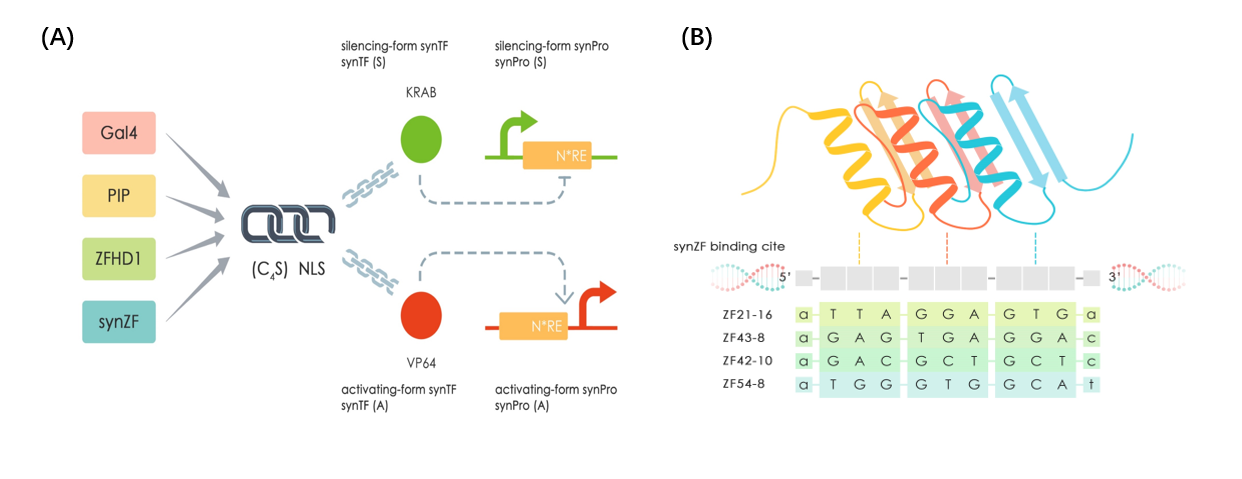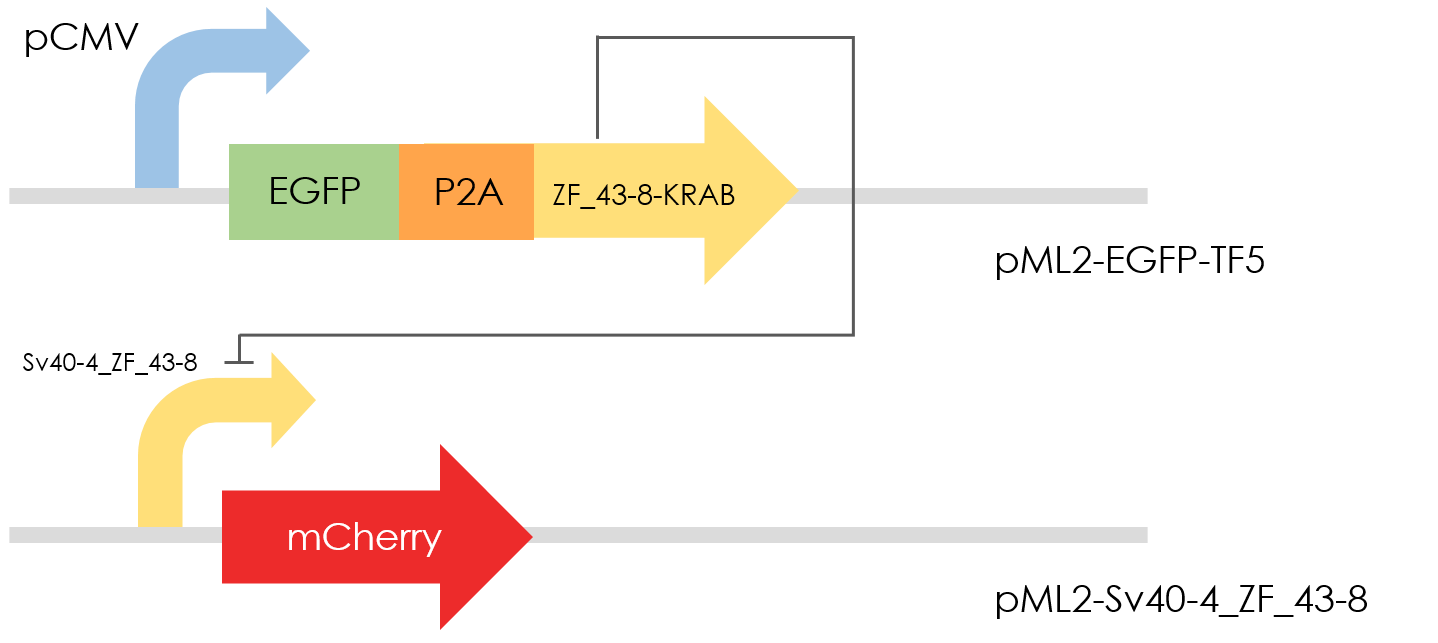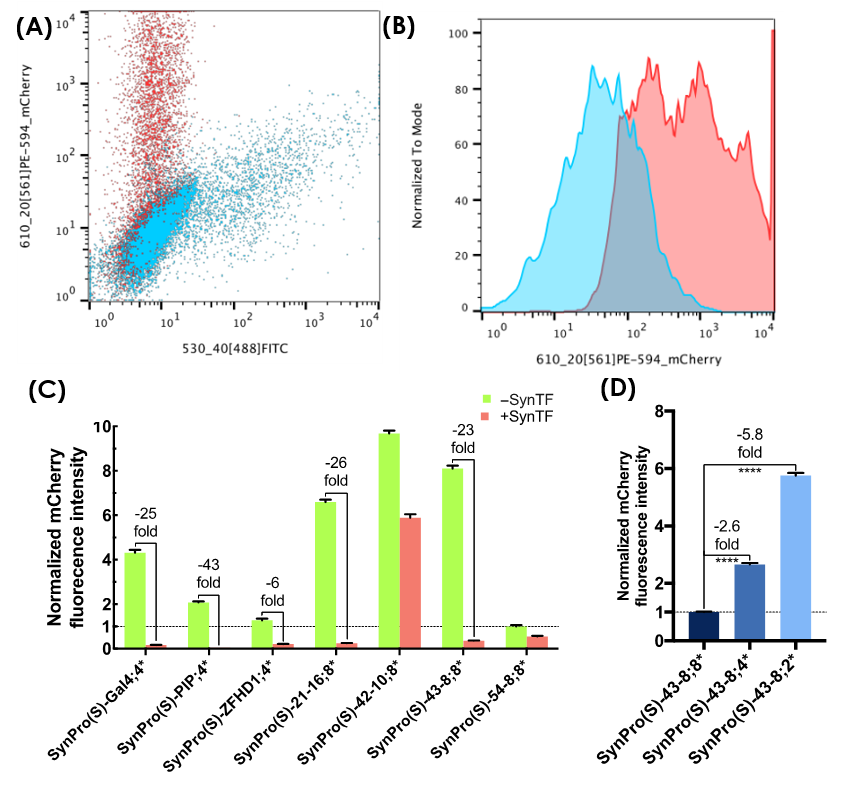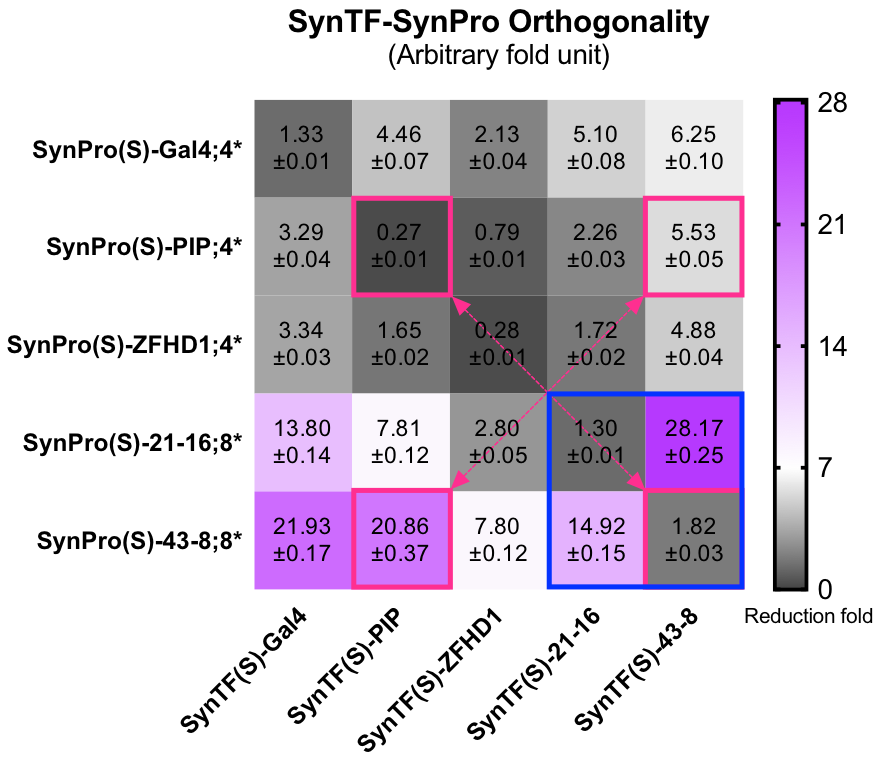Part:BBa_K2446028
SV40_8_ZF_43-8 promoter
This part (Sv40 8*ZF_43-8) is a mammalian synthetic promoter (SynPro) based on Sv40 promoter (BBa_K2446052) and two repeats of Zinc Finger_43-8 binding sites. We inset the 8*ZF_43-8 binding sites behind the Sv40 promoter. Sv40 promoter is a constitutive expression promoter from the simian vacuolating virus 40. In this way, we can use our mammalian synthetic transcription factors (SynTFs) which is a fusing protein ZF_43-8 _DBD_(G4S) linker_NLS_KRAB. The ZF_43-8-DBD can bind to the 8*ZF_43-8 binding sites specifically[1] and the KRAB domain can repress the expression of Sv40 8*ZF_43-8 promoter [2]. The corresponding SynTF of Sv40-4*ZF_43-8 is ZF_43-8 _KRAB (BBa_K2446041). The three promoter repressed by ZF_43-8 _KRAB have different repeats of response elements. Which the Sv40 2*ZF_43-8 BBa_K2446026 has two repeats, and Sv40 4*ZF_43-8 BBa_K2446027 has four repeats, Sv40_8*ZF_43-8 BBa_K2446028 have eight repeats. Through the experiments, we prove that we can adjust the repressed intensity of SynPros by change the repeats of the response elements of SynTFs. This part is the strongest one in three SynPros.
The information of other SynTF-SynPros are showed in the table below.
| SynTFs | SynPros |
|---|---|
| Gal4-KRAB(TF-KRAB-1) BBa_K2446037 | Sv40-UAS(Sv40-UAS) BBa_K2446036 |
| ZF_PIP_KRAB(TF-KRAB-2) BBa_K2446045 | SV40_2/4/8_PIP BBa_K2446033/BBa_K2446034/BBa_K2446035 |
| ZF_21-16KRAB(TF-KRAB-3) BBa_K2446039 | SV40_8_ZF_21-16 BBa_K2446030 |
| ZF_42-10_KRAB(TF-KRAB-4) BBa_K2446040 | SV40_8_ZF_42-10 BBa_K2446025 |
| ZF_43-8_KRAB(TF-KRAB-5) BBa_K2446041 | SV40_2/4/8_ZF_43-8 BBa_K2446026/BBa_K2446027/BBa_K2446028 |
| ZF_54-8_KRAB(TF-KRAB-6) BBa_K2446042 | SV40_8_ZF_54-8 BBa_K2446029 |
| ZFHD1_KRAB(TF-KRAB-7) BBa_K2446043 | SV40_4_ZFHD1 BBa_K2446032 |
Sequence and Features
- 10COMPATIBLE WITH RFC[10]
- 12COMPATIBLE WITH RFC[12]
- 21COMPATIBLE WITH RFC[21]
- 23COMPATIBLE WITH RFC[23]
- 25COMPATIBLE WITH RFC[25]
- 1000COMPATIBLE WITH RFC[1000]
Experiments
An tunable SynTF-SynPro Pair
Figure 2: the testing circuits of ZF_43-8-KRAB& Sv40-8_ ZF_43-8 pair
This pair of SynTF-SynPro works well in mammalian cells. To make sure the SynTF-SynPro pairs work in mammalian cells, we use the circuits above to test if the ZF_43-8-KRAB can repress the expression of Sv40-8_ZF_43-8 indeed. ZF_43-8-KRAB is linked to the C terminal of EGFP by the link of P2A. And mCherry expressions is controlled by corresponding SynPro (Sv40-8_ ZF_43-8). These circuits are both inserted in to the mammalian expression vactor pML2. We transfect pML2-Sv40-8_ ZF_43-8 into Hela cells and measure the fluorescence intensity of mCherry by flow cytometer to get the basic expression intensity of Sv40_ ZF_43-8. We also co-transfect the pML2- ZF_43-8-KRAB with pML2-Sv40-8_ ZF_43-8 into Hela cells at the same time. Then measure the fluorescence intensity of mCherry again to get the expression intensity of Sv40-8_ZF_43-8 influenced by ZF_43-8-KRAB. The results of the experiment is showed below. The SynTF ZF_43-8 can silence the expression of the SynPro Sv40-8_ZF_43-8 in 23 folds.
An tunable SynTF-SynPros pair. The zinc finger is a highly structured motif. In tandem with multiple zinc finger motif, the recognition precision can be enhanced in its one part of usage in genome editing [3]. We applied this strength trying on constructing tunable SynTF-SynPro pairs. We observed that the inhibitor intensity was enhanced by adding more RE repeats. In the same way, we test the silencing intensity of c-KRAB to the Sv40_ promoter with 2/4/8 repeats of ZF_43-8 binding sites. There shows a significant difference of silencing intensity (figure 3-D), so that we can use the same way to engineer and adjust the SynPros that we need.
Figure 3:The results of ZF_43-8-KRAB&SV40_8_ZF_43-8 testing: (A) The red points is the cells before co-transfecting ZF_43-8-KRAB and the blue points is the cells after co-transfecting ZF_43-8-KRAB. It’s easy to see that the red points depart from the diagonal and higher than the blue pints. So the expression of mCherry silenced after the expression of ZF_43-8-KRAB;(B) The red area is the fluorescence intensity of mCherry before co-transfecting ZF_43-8-KRAB and the blue area is the intensity after co-transfecting ZF_43-8-KRAB.(C) The statistical result of all of the SynTFs-SynPros pairs: ZF_43-8-KRAB can silence the expression intensity of Sv40-8_ ZF_43-8 in 23folds.(D) Tuning the silencing fold by adjusting the RE repeats of 2*, 4*, 8* on SynPro(S)-43-8. Values are the mean of n = 3 ± SEM. ****, p < 0.0001.
SynTF-SynPro Orthogonality
To construct our [http://2017.igem.org/Team:Fudan/Model/GTN| Strip module], more than one SynTF-SynPro pairs would be applied. Thus, the interaction between the pairs would influence or ruin our construction. We did massive orthogonality experiments to avoid that. We observed all of the 5 pairs were actually orthogonal, as you could see the grids on the diagonal were always the darkest. The three DBDs commonly used in previous works were didn’t let us down. However, the expression level of these RE loaded SynPros were relative low compared to SynPro(S)-ZF serials. As the blue rectangle in the lower right corner of the orthogonality may showed the SynPro(S)-ZF has high basic expression with unpaired SynTFs, but could be silenced to the similar fold of commonly used DBDs corresponding SynPros. The SynPro(S)-ZF was likely won’t be target by other unpaired DBD, hence the purple appeared on the bottom rows.
Figure 4: the SynTF-SynPro pairs’ Orthogonality. Grids in blue rectangle showed that SynTF-SynPro pairs constructed by using SynZF as DBD with well orthogonality. Grids in pink rectangles replaced our favorite SynTF-SynPro pairs. At least 20,000 cells were analyzed for each condition in both histogram and each grid in heat map. Data are recorded by FACS at 24h after cotransfecting.
References
[1] J. J. Lohmueller, T. Z. Armel, P. A. Silver, A tunable zinc finger-based framework for Boolean logic computation in mammalian cells. Nucleic Acids Research 40, 5180--5187 (2012).
[2] R. Witzgall, E. O'Leary, A. Leaf, D. Onaldi, J. V. Bonventre, The Krüppel-associated box-A (KRAB-A) domain of zinc finger proteins mediates transcriptional repression. Proceedings of the National Academy of Sciences 91, 4514-4518 (1994).
[3] A. Klug, The discovery of zinc fingers and their applications in gene regulation and genome manipulation. Annual review of biochemistry 79, 213--231 (2010).
| None |




